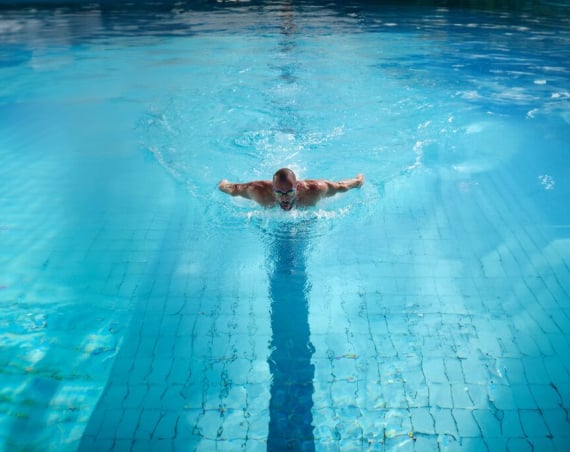How much exercise do kids need? Children and young people should average at least 60 minutes of physical activity a day according to the NHS. The advice is for them to do different types of physical activity throughout each week.
Fortunately, there are plenty of ways for kids to enjoy a variety of exercises, from the playground to the playing field. But what about the gym?
If your child has expressed an interest in joining you at the gym, you might be wondering where to start. We’ll explain everything you need to know if your kids are gym-curious and you want to support them.
Key takeaways
Want the quick version? These are the key points.
- Most gyms set age restrictions — often 11+ with supervision — to ensure safety.
- Junior memberships and sessions create a supportive space tailored to young fitness enthusiasts.
- Under-16s typically need parental consent and supervision to exercise safely.
- Age-appropriate workouts focus on bodyweight moves, light resistance and good form to build strength without injury.
- Inductions with certified trainers teach proper equipment use and safe technique.
- Keeping exercise fun and varied helps kids stay motivated and confident.
- The gym supports more than fitness: it can improve wellbeing, build discipline and offer family time.
- Gradual progression and good recovery habits are key for long-term healthy development.
Getting started
There’s a first time for everything! If the gym is uncharted territory for your young one and you want to ease them in gently, make sure you:
- Check age limits: Policies vary at different gyms. At David Lloyd Clubs, children aged 10+ can take part in our Start-Up programme, which introduces them to various pieces of gym equipment. Afterwards, children are free to use the gym during supervised sessions or when accompanied by a parent or guardian. Kids aged 15+ can use the gym freely with no supervision.
- Work with the experts: When it comes to personnel, not all gyms are set up to accommodate younger members. See if your gym has a Personal Trainer who’s experienced in young people’s fitness, and knows exactly how to adjust exercises and routines for children’s safety and growth.
- Try a parent-child session: To bridge any initial hesitation, start by booking a parent-child or family fitness session, if available. It’s a fantastic opportunity for kids to understand gym dynamics under your watchful eye.
Your role as a parent
Being a parent means wearing many hats. When it comes to the gym, you become your child’s guide, cheerleader and safety monitor all in one. Your guidance and encouragement can help shape your child’s fitness journey.
- Boost their confidence: A little praise goes a long way. Celebrate their small achievements, and let them know you notice their efforts. It’s essential, however, to maintain a balance and not push too hard.
- Put safety first: The gym is a new environment, and your job is to ensure your child is safe, attentive and following the rules.
- Emphasise post-workout recovery: Don’t underestimate the importance of post-workout recovery, even for children. Teach them the importance of cooling down, stretching and hydrating.
- Encourage variety: Help your child try different equipment and exercises so they can find what they enjoy. Exercise shouldn’t feel like a chore, particularly when you’re young!
- Talk about body image and self-worth: Reinforce the idea that the gym is about improving and maintaining your overall well-being. People of all ages should exercise for their health, fitness and happiness — not to look a particular way.
Gym exercises for kids
Time in a structured gym environment can give kids more than just a fitness boost; it can also have benefits for their discipline, motivation and mental health. The key to unlocking these benefits is to adapt exercises and classes to each age group and fitness level.
Depending on the gym you’re visiting, there may also be other on-site fitness facilities they can use to help boost health and well-being.
- Strength training: As you might expect, strength training for kids doesn’t mean strenuous weightlifting. The focus should instead be on light resistance training, which helps improve muscle tone, strength and posture.
- Cardio workouts: Cardio is essential for heart health and endurance, and can also be a lot of high-energy fun! See if your local gym offers a family circuit session based on the gym floor. These sessions utilise a range of gym equipment (treadmills, exercise bikes, ellipticals and more) to provide a varied, energetic class for the whole family.
- Swimming: Swimming is a blast for kids and, more importantly, provides a full-body workout. If your gym has a pool, look for swimming programmes that tailor classes to children’s abilities as they progress through stages and become confident, competent swimmers.
- Group classes: Kids clubs and activities give little ones the opportunity to play and learn alongside others as they discover new passions, which can be highly beneficial for their general development.
- Holistic exercises: Just like their parents, kids and teens can benefit from a little respite from the outside world, and yoga fits the bill perfectly. Keep an eye out for yoga classes that cater to the physical and mental well-being of younger age groups.
Spend quality time together
Beyond the obvious benefits for your child’s fitness, confidence and self-worth, the gym opens up new opportunities to spend quality time together as you motivate each other and share your achievements. That’s why at David Lloyd Clubs we’ve always championed that all-important ‘we time’ — and not just in the gym. We offer a terrific range of activities, games and facilities for the entire family, including our popular Fitness Into Teens programme specifically for kids aged 10-15.
Whichever way you decide to introduce your child to the gym, it should be an enriching experience. With the right blend of safety, support and fun, it’s a journey they’ll cherish for many years. Just remember to let them explore and settle on what they genuinely enjoy.
Interested in exploring the benefits of membership at David Lloyd Clubs? Find your nearest club to get started.
Find a club



